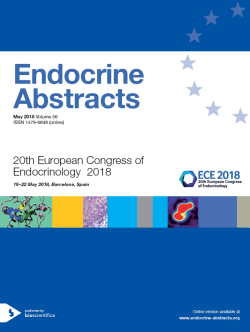Searchable abstracts of presentations at key conferences in endocrinology

20th European Congress of Endocrinology
Barcelona,
Spain
19 May 2018 - 22 May 2018
ECE 2018, 19 - 22 May 2018; Barcelona, Spain
Symposia
Novel aspects of Craniopharyngioma
ea0056s11.1 | Novel aspects of Craniopharyngioma | ECE2018
Molecular pathogenensis of craniopharyngioma
Craniopharyngiomas (CPs) are tumours located in the sellar and parasellar region, thought to have an embryonic origin and/or to arise from pituitary progenitors/stem cells. They have an overall incidence of 12 new cases/million population/per year and are subdivided into two histologically different subtypes, adamantinomatous (aCPs) and papillary (pCPs). The clinical manifestations at diagnosis for CPs are: headache, visual disturbances, polyuria/polydipsia, endocrine dy...
ea0056s11.2 | Novel aspects of Craniopharyngioma | ECE2018
Bariatric surgery as treatment in craniopharyngioma
Patients with craniopharyngioma suffer from excess mortality and morbidity, especially patients with childhood onset of the disease. The impaired outcome in these patients is in part related to hypothalamic obesity, which is mainly caused by hypothalamic damage. The hypothalamic damage seems to result in autonomic nervous system dysfunction as well as leptin and insulin resistance. These factors negatively affect food intake, food satisfaction, metabolism and energy expenditur...
ea0056s11.3 | Novel aspects of Craniopharyngioma | ECE2018
The psychosocial, neuroendocrine and cognitive effects of childhood craniopharyngioma
Craniopharyngiomas are paradoxically considered benign and hence curable by complete excision. Despite a high survival rate, however, this notion belies a high morbidity and propensity for premature mortality from neuroendocrine disease and treatment complications in those diagnosed in childhood, whose disease differs from that in adulthood. These result from a proximity to, and invasion of, vital ophthalmic, neurometabolic, neurocognitive and neuroendocrine pathwa...



